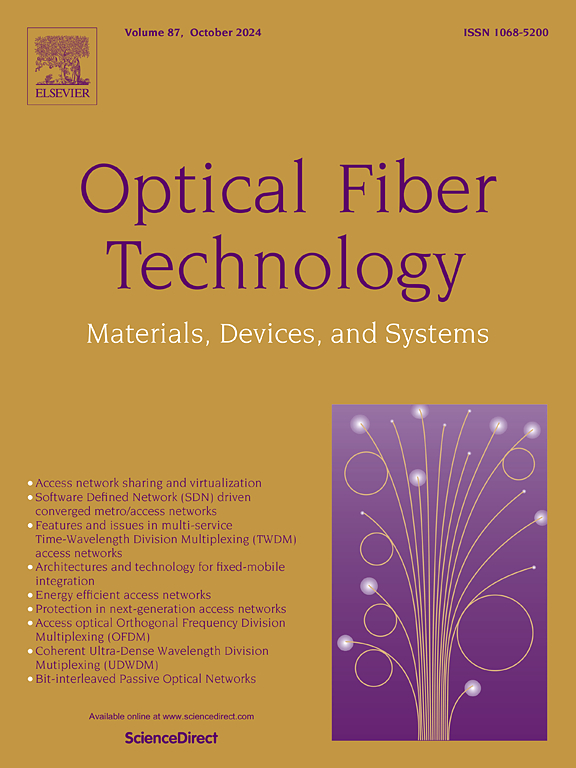利用倾斜光纤头控制光遗传学中的空间光学照明
IF 2.6
3区 计算机科学
Q2 ENGINEERING, ELECTRICAL & ELECTRONIC
引用次数: 0
摘要
光遗传学工具的出现彻底改变了神经科学研究,它通过光照表达蛋白的神经元,在时空上精确激活特定神经元。体内光遗传学的一个长期挑战仍然是如何将光同时传送到多个大脑部位并保持高空间分辨率。为应对这些挑战,人们提出了基于光纤的技术。这项工作展示了基于双面斜角尖端(DSAT)结构的创新型斜角光纤探针的制造和表征。为实现光滑 DSAT 探头的可重复性制造,采用了定制的光栅装置。所设计的探针能对脑组织中的光传播进行精确的空间控制,其中 DSAT 的针尖成 55° 角,最大横向照明位置为距离光轴 ± 420 μm,使用 5 mW 的 473 nm 激光,峰值辐照度为 478.5 mW/mm2。此外,还根据光线追踪方法对设计的 DAST 探头进行了模拟,并获得了实用的尖端角度,以评估 DSAT 在 0° 至 12.5° 的各种输入光学角度下发射的光线的传播情况,从而预测它们在模拟组织中的辐照度和位置。结果表明,探头产生了两个椭圆环,每个环包含两个光浓度较高的光斑。因此,该装置提供了四个具有辐照度峰值的光斑,可同时照射脑组织中的四个不同位置。获得的实验结果与模拟结果非常吻合,可用于光遗传学应用中的脑组织多点照明。本文章由计算机程序翻译,如有差异,请以英文原文为准。
Controlling spatial optical illuminations in optogenetics using an angled optical fiber tip
The advent of optogenetic tools has revolutionized neuroscience research through its spatiotemporally precise activation of specific neurons by illuminating light on opsin-expressing neurons. A long-standing challenge of in vivo optogenetics remains in delivering light to multiple brain sites simultaneously and maintaining high spatial resolution. Optical fiber-based technologies have been proposed to address these challenges. This work presents the fabrication and characterization of an innovative angled optical fiber probe based on a double-sided angled tip (DSAT) structure. A custom griding setup was used for the reproducible fabrication of a smooth DSAT probe. The designed probe enables precise spatial control of light propagation in brain tissue in which DSAT at angled tip 55° achieving a maximum lateral illumination position of ± 420 μm away from the optical axis and a peak irradiance of 478.5 mW/mm2, using a 5 mW of 473 nm laser light. Also, the designed DAST probe was simulated based on ray tracing method and obtained the practical tip angle to evaluate the propagation of light rays emitted from the DSAT at various input optical angles ranging from 0° to 12.5° to predict their irradiance and positions in the modelled tissue. The results indicate the probe generates two elliptical rings each containing two spots with higher optical concentration. Consequently, this device provides four optical spots with irradiance peaks that enable simultaneous illumination of four different locations in the brain tissue. Obtained experiment results are in good agreement with simulation results which can be used for multipoint illumination of brain tissue in optogenetics applications.
求助全文
通过发布文献求助,成功后即可免费获取论文全文。
去求助
来源期刊

Optical Fiber Technology
工程技术-电信学
CiteScore
4.80
自引率
11.10%
发文量
327
审稿时长
63 days
期刊介绍:
Innovations in optical fiber technology are revolutionizing world communications. Newly developed fiber amplifiers allow for direct transmission of high-speed signals over transcontinental distances without the need for electronic regeneration. Optical fibers find new applications in data processing. The impact of fiber materials, devices, and systems on communications in the coming decades will create an abundance of primary literature and the need for up-to-date reviews.
Optical Fiber Technology: Materials, Devices, and Systems is a new cutting-edge journal designed to fill a need in this rapidly evolving field for speedy publication of regular length papers. Both theoretical and experimental papers on fiber materials, devices, and system performance evaluation and measurements are eligible, with emphasis on practical applications.
 求助内容:
求助内容: 应助结果提醒方式:
应助结果提醒方式:


